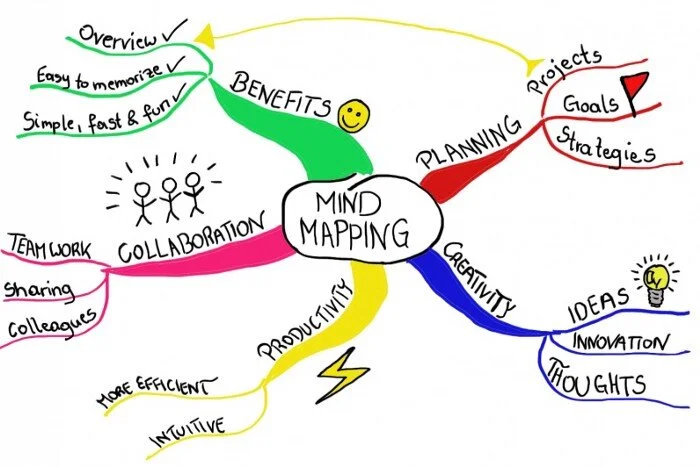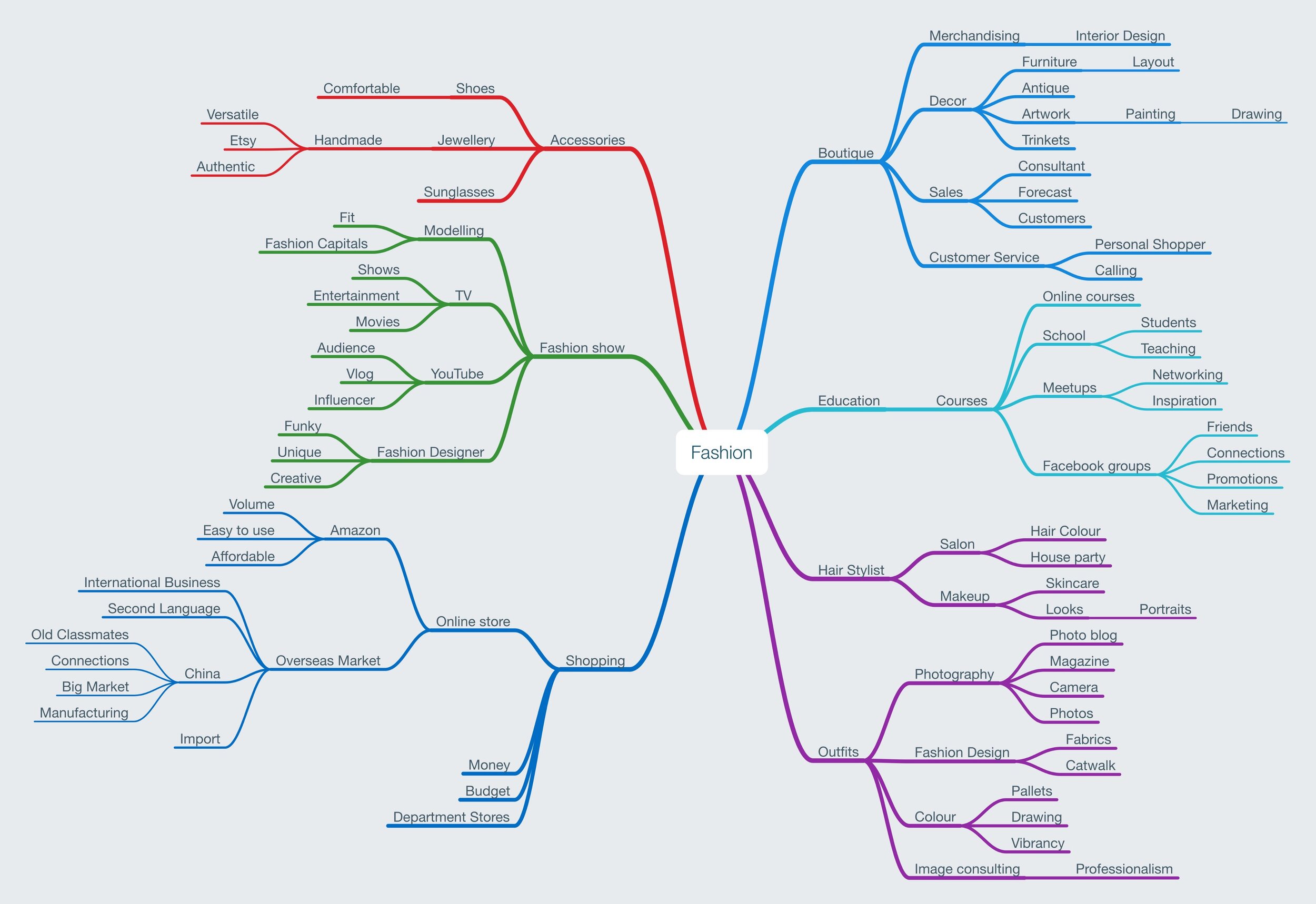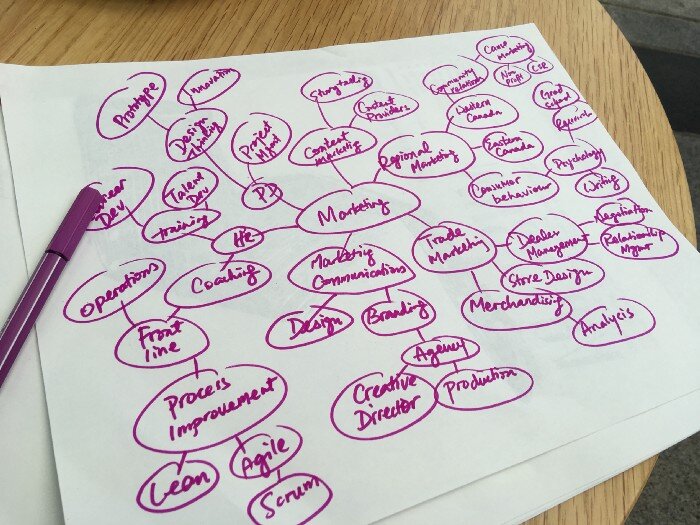3 Ways to Use Mind Mapping to Design Your Career & Get Unstuck
Mind mapping is an effective way to facilitate ideation, note taking and project planning. It generally starts with a simple idea or topic in the centre and the user would put ideas related, or inspired by the central idea around it, and connect all the ideas with lines. The user would then repeat the process for each idea generated to produce more ideas, just like a tree growing many new branches.
Here is a mind map illustrating various benefits of mind mapping from an article from MindMeister.
5 Things to Remember When Mind Mapping
Put down only keywords, short phases or images, not sentences! This simplicity allows you to jot down ideas a lot faster and generate more ideas.
Adopt a “no filter” rule. Don’t overthink or judge whether your idea is good or bad, original or realistic. Write whatever that comes to mind as this approach works naturally with the way your brain works, and “frees up space” to allow for more ideas to be spun out of it.
To get as many ideas as possible, it’s crucial that you have at least 5 related ideas coming out of your main topic (note: they don’t have to be logical or belong to the same category). Next, you want to build on each idea at this secondary level by drawing 3–4 lines from the word or phrase, and repeat the same exercise. Whatever you write down doesn’t need to be related to your main topic.
You want to have more than 4 “rings” or levels of ideas, so you can have more breath and depth of ideas rather than stating what you already know.
Using a big piece of paper, a large whiteboard or a good software prevents your tool from restricting your number of ideas.
How to Mind Map for Your Career
You may have used mind mapping to brainstorm at a professional setting, but have you used it to plan your career?
In the book Designing Your Life (2016, page 71) , Bill Burnett and Dave Evans suggest applying mind mapping, a technique often used in product innovation, to reinvent and design one’s career. They even developed a course called Designing Your Life for Stanford University’s undergrads, which unsurprisingly became one of the school’s most popular courses.
The authors argue that often times we feel “stuck” in our career because of two very simple reasons:
We have limited number of ideas on what the next chapter of our career could turn out.
We make assumptions on certain career choices without sufficiently validating them.
Burnett and Evans suggest using mind mapping to maximize the number of career ideas, and create concepts which can turn to career “prototypes” so the user can have more concrete directions to “test” their “prototypes”. Here are the 3 steps to mind map your career ideas suggested in the book:
Select a topic
Create a mind map
Make “secondary connections” among the ideas on the map and develop a few concepts from the ideas on the map.
Mind map your career #1: career change
Let’s demonstrate this method by mind mapping the career ideas for one of my friends. Let’s call her Annie.
Annie used to work in the hotel administration business before moving to Canada from China. She completed a business degree in Vancouver and always wondered if there’s something in the realm of fashion she could pursue as that’s something she’s always interested in. It took her 2 years just thinking about it without getting anything done because the idea of owning a clothing boutique (her obvious choice) seems very daunting — She doesn’t have much to invest in it, nor does she have any training in fashion.
Annie finally got fed up by her boring job at a car dealership and decided to take up mind mapping with me to explore what options she had. Here is the map that we came up with using this iOs app called MindNode.
Mind map used to brainstorm what fashion related career options Annie has
As we put our two creative heads together, our careers ideas took on wings of their own and started going many different directions.
Let’s zoom in to step 3 of mind mapping for a bit:
Since mind maps show relationships between ideas, they really help you see patterns or generate insights from the data generated.
As suggested by Burnett and Evans in Designing Your Life (pages 72–73), the last step after the mind map is created is to pick some ideas that you find interesting to you and combine them together to create a “concept”, or insight. Ideally these ideas you pick are further out from your main topic as they are further away from your “conscious thinking”.
Here are a few concepts Annie derived from her mind mapping exercise:
She almost forgot about her hobby of interior design (people kept telling her that she’s really good at designing her apartment) and decided to take some online courses to learn more and potentially become a freelance interior designer one day. She’s cool with doing it for fun on the side, too.
She could source funky and affordable handmade jewelry from some contacts in China and open an online store.
She could leverage her international business background and help North American designers export to China to tap into its huge market.
This mind map unveiled some career options that Annie never thought about. The level of detail also gave her brain clearer and more tangible visions. This heightened perceived certainty (our brains’ BFF) made her more comfortable to explore those options and create action items. For example, for career option 1, she has gone to a few Meetups, visited a few clothing boutiques with great design, and found a new community of people who appreciate her enthusiasm and expertise. Annie hasn’t fully reached any “ultimate” goal yet, but she’s happy that she is way closer to the creativity field and she is actively exploring opportunities and building partnerships in this realm. The more information she collects, the more refined her prototypes become: It’s no longer “getting a job in fashion” now, one of them is “becoming an eCommerce leader who supports grassroots designers in China and Canada with their overseas market expansion”. What a great career option that sits right at the intersection of her passion for design and training in business!
Mind map your career #2: career enhancement
What if you are not thinking about changing career? You are just considering moving up, horizontally or diagonally in your organization? Mind mapping can help as well. Here is how I mind mapped my “footprint” and future opportunities after a 7-year marketing career in a Canadian telecom.
A mind map on my 7-year marketing career at a telecom and where I could go next
This is also a great exercise that reveals what you enjoy the most, where your connections are and a sense of where you want to move further into.
Mind map your career #3: career exploration
What if you only know that you are very good at a rough functional area, such as business analysis, and you are stuck there without knowing which direction to build on that expertise and make it a career? You can research on job postings with the “business analyst” keyword and create a mind map to reveal how this role is applied in many many different areas of business and decide on which type you are more drawn towards. Here is an example.
A mind map on where business analysis skills can be used
What if you struggle to come up with ideas?
You may know too little about the subject. When I created the mind map above, I realized that I could have learned more about various aspects of data science, so I spent 10 minutes scanning job descriptions on LinkedIn Jobs. What a great way to reveal a knowledge gap, which prompted me to learn about a field I thought I knew a lot about! Reading blogs on the subject and doing informational interviews, will also help in this regard.
You may be so ingrained in your own world that you need some different perspectives. Find a brainstorming partner or two. Pick someone with a different background or lots of knowledge in their field, or, someone who’s creative and resourceful.
You may be “censoring” your ideas too much and trying to be too rational. Pause the process. Go do something else fun or relaxing and come back to the game. Curiosity and openness are essential in “prototyping” your career.
Tell us what you think!
I hope all these examples gave you a better sense of how to use mind mapping to help generate ideas to solve your career (and even life) problems. I have frequently used this tool with students and clients I support, who have all reported enhanced confidence with their career prospects and clarity on their next steps.
Are you ready to give mind mapping a try? Share your comments or questions here!
Mind Mapping Tools I’ve tried:
MindNode: There’s an (iOs and Mac) app for that! Easy to use on the iPhone and seems free right now. The Mac version comes with a free trial.
MindMeister: Easy to use and can start for free but you need to pay a small monthly subscription to be able to export your map.
Photo by Husniati Salma on Unsplash




